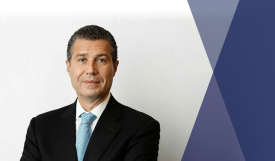Peruvian Director Adrian Saba on the Making of 'El Sonador (The Dreamer)'
Back in 2012, Peruvian filmmaker Adrian Saba put together a small independent film called "El Limpiador (The Cleaner)." The film, set in post-apocalyptic Lima, not only made the rounds at prominent international film festivals but became a huge hit in his home country and was selected by the nation's film commission as its official submission for that year's Academy Awards' category for Best Foreign Language film.
"El Limpiador" never made the cut at the Oscars, but the film's success launched Saba's career and made him well-known in his country.
Almost three years since the success of "Limpiador" the filmmaker is at it again with his second feature titled "El Sonador (The Dreamer)." The film is set across a wider range of Peruvian locations, including prominent sequences in the desert and ocean.
Saba, who is currently in New York working on the film with editor Justin Beach, spent some time talking with Latin Post about the grueling process that has been the making of "El Sonador" and how it differed from his first feature film.
David Salazar: I remember learning about the project two years ago, when "El Limpiador" was making the rounds, and I saw an early draft of "El Sonador." Has it changed much since then?
Adrian Saba: That's a long time. I can't believe it's been that long. I don't know what draft you read but we shot draft, I think, 10 of the script. I think you read draft three.
DS: So how is it different from that draft?
AS: The heart is still the same. I am still honestly finding out about the film in the editing room. So far I think the movie is about trying to fight your destiny. I don't know if I like how it sounds. But I always wonder about the things that we live through. Do we live them because we choose to or because we have to? Is it possible to go against those things? Will we fail if we do?
DS: If I recall correctly, that old draft had your main character growing up in modern-day Lima, but occasionally being whisked off into a desert, which was a metaphor for what was happening in his current life. Is that something that remained in the later versions of the script?
AB: Yes, it is there.
DS: Was it expanded upon?
AB: This is a tough question. It would be easy to say that the character uses dreams to escape. You could say that the moment something is not going well he uses a dream and escapes the situation. They take place in different parts of nature, because I think they are nice counterparts to the industrial city. And nature has a sense of freedom and something that we can't control and didn't create. It is beyond us. That is why the dreams happen in nature.
We are still trying to find out how to make the dreams more than an escape for him.
DS: Stylistically, is there something you do differently in the settings? Or is the mis-en-scene enough to give us that idea?
AB: We are trying to work out different ideas. We are seeing if maybe music cues will work. It is interesting at this moment because you are looking to define the story and you are trying out different methods to get the idea across. We are also working with sound. Some of the dialogue might suddenly have more reverb or echo in certain environments. It's an interesting experience and exploration.
DS: Are there any themes that carry over from that film to this one?
AB: There are probably more than I know but I realized that both of the kids are orphans. I don't know what that means, but I realized that. But aside from that I honestly don't know. You're probably going to be the one to tell me if there are any other patterns or themes that carry over.
DS: You just mentioned the number of locations being far greater than "Limpiador." Do you think that was the most difficult aspect of production? Managing all of those locations into a short schedule?
AB: Everything adds up. Especially, the amount of time to shoot the movie. It took five and a half weeks to shoot and I still wish I had a few more days. But all directors say that.
And five weeks and a half was a lot more than I had ever done. I did "El Limpiador" in 21 days. And to go from three weeks, which were scattered over two months, to five weeks non-stopped was different for me.
DS: I know that you did the Cannes writers lab a few years ago to write the script. After that what was the process like and how did it differ from your first movie?
AB: With "Limpiador" nobody cared about the film, so to speak. It wasn't until after that they started to pay attention. But in this case I did labs and workshops and would go to markets and meetings and people knew about it before it was even made.
DS: Did it put more pressure on you?
AB: Of course, but it's about putting it aside. I don't think I will ever have the experience of "Limpiador" again. I mean making a movie that no one cares about. If you fail, no one will know. People ask me about my movie now. In the street I will meet someone and that is the first thing they ask me about. With "Limpiador" no one ever asked me.
DS: So for "Limpiador" you had Victor Prada, who is relatively well-known in Peru. But this time you went with lesser known actors. Why was that?
AB: I wanted to work with a cast that was my age and wanted to see what that was like. My actors have done a few things. The main actor has done some TV shows. Maybe the real reason why they aren't as well-known is because they are starting out.
For "Limpiador" I didn't do a casting process, so for this one I wanted to see what that was like.
DS: How was the process of casting for you?
AB: I honestly don't like the process of auditions. I think they are so cold and I feel terrible for the actors and usually don't think that you get their best because they are nervous and have little time to prepare. Usually the lighting in the room is not great and you are in a position of power and judging them.
At the beginning I met with people and had coffee with them. But that was taking too long and I couldn't pay for everyone's coffee. So I had to give in and did around six days of auditions. Maybe 20 minutes each person.
But it was fun because you get to direct a bit and see what people offer.
DS: You worked with Cesar Fe in "Limpiador" and brought him back for this one. How was it working with him on "El Sonador" and how do you think your working relationship developed on this film?
AB: We are great friends. We grew up a bit I guess. It was certainly a bigger film and the camerawork was more demanding. We had long sequences and had more handheld work.
DS: This was shot on the [ARRI] Alexa right?
AB: Yes it was.
DS: So he handheld the Alexa the entire time (the Alexa weighs over 20 pounds when fully rigged and equipped)?
AB: It was so heavy. You could see how Cesar started in the first days, struggling a lot, and by the third week he had no problem. Even the steadicam operator we hired was falling apart by the sixth day of working with us.
DS: What range of lenses did you use?
AB: We shot a lot on 32mm. I think that was the one we used the most. We also used the 75mm. We shot wide open on the F-stop. I don't remember the number. I think it was 2.8. We also used a 50mm or 100mm, but I feel that 32mm was the one we used the most.
DS: Was there any inspiration or filmmaker that you worked off of when coming up with this style?
AB: No. I think that is in everyone's mind. The ideas developed as it went along. I had a team that made the movie grow by bringing ideas to the table. For example the abandoned boat was not in script. We were location scouting and we just happened upon the boat. But the idea of it being green was in the script.
DS: How far from Lima did you shoot?
AB: We flew to one location, about 10 of us, including actors. It was a small scene. We would fly in at night, shoot the next day and then leave the following day. We had about four days of scouting outdoor locations. We went to the desert one weekend.
DS: How long did it take?
AB: The whole pre-production process was three months. I started writing the script January 2013. I actually started thinking about it around fall 2012 and in January I started writing the first draft. All of 2013 I kept on writing. Same for 2014. I took some breaks in between. I would apply to funds and grants.
DS: So when did pre-production actually start and when do you think the film will be released?
AB: It started I think around September or October 2014. We started shooting at the start of 2015. I'm hoping it's out there in 2016.
Subscribe to Latin Post!
Sign up for our free newsletter for the Latest coverage!
© 2026 Latin Post. All rights reserved. Do not reproduce without permission.














